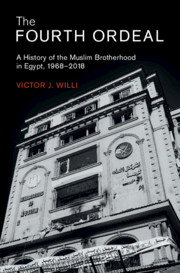Book contents
- The Fourth Ordeal
- Cambridge Middle East Studies
- The Fourth Ordeal
- Copyright page
- Dedication
- Contents
- Plates, Figures and Tables
- Acknowledgements
- Note on Transliterations and References
- Note on Sources
- Chronology of Events
- Dramatis Personae
- Abbreviations
- Prologue
- Introduction
- 1 The Society of the Muslim Brothers
- 2 The Second Founding (1968–1981)
- 3 The Rise of the Vanguard (1981–1991)
- 4 Brotherhood Incorporated (1991–2001)
- 5 Struggle for Leadership (2001–2011)
- 6 Revolution, Rise and Fall (2011–2013)
- 7 The Beginning of the Fourth Ordeal (2013–2018)
- Conclusion
- Epilogue
- Glossary
- Bibliography
- Index
- Books in the Series
- Plate Section
- Plate Section
2 - The Second Founding (1968–1981)
Published online by Cambridge University Press: 02 February 2021
- The Fourth Ordeal
- Cambridge Middle East Studies
- The Fourth Ordeal
- Copyright page
- Dedication
- Contents
- Plates, Figures and Tables
- Acknowledgements
- Note on Transliterations and References
- Note on Sources
- Chronology of Events
- Dramatis Personae
- Abbreviations
- Prologue
- Introduction
- 1 The Society of the Muslim Brothers
- 2 The Second Founding (1968–1981)
- 3 The Rise of the Vanguard (1981–1991)
- 4 Brotherhood Incorporated (1991–2001)
- 5 Struggle for Leadership (2001–2011)
- 6 Revolution, Rise and Fall (2011–2013)
- 7 The Beginning of the Fourth Ordeal (2013–2018)
- Conclusion
- Epilogue
- Glossary
- Bibliography
- Index
- Books in the Series
- Plate Section
- Plate Section
Summary
This chapter looks at the Brotherhood’s re-emergence during the seventies to illustrate how an organization that had been dismantled for twenty years managed to re-constitute itself as an important actor on Egypt’s social and political scene. Starting with the life of the third General Guide, ‘Omar al-Tilmisani, the story traces the trajectory of senior leaders after their release from prison between 1971 and 1974. It also introduces the religious student activists, who came to control the student unions of Egyptian universities countrywide, and the debates that surrounded the gradual integration of the Jama‘a Islamiyya under the umbrella of the Brotherhood. The chapter ends with the crackdown of September 1981, the subsequent assassination of President Anwar al-Sadat, and the split of the Islamic movement in the context of the Camp David peace negotiations between Israel and Egypt. Based on personal memories of key leaders, Oral History interviews with organizational members, a reading of the Brotherhood’s al-Da‘wa magazines as well as of other relevant prison-writings, pamphlets and magazines, and a survey of the scholarly literature, the chapter shows how, over the course of the decade, different cultures and value-system became untied within the framework of the Muslim Brotherhood, laying the basis for what would – over subsequent decades – lead to growing organizational disagreements within its ranks.
Keywords
- Type
- Chapter
- Information
- The Fourth OrdealA History of the Muslim Brotherhood in Egypt, 1968–2018, pp. 50 - 99Publisher: Cambridge University PressPrint publication year: 2021

